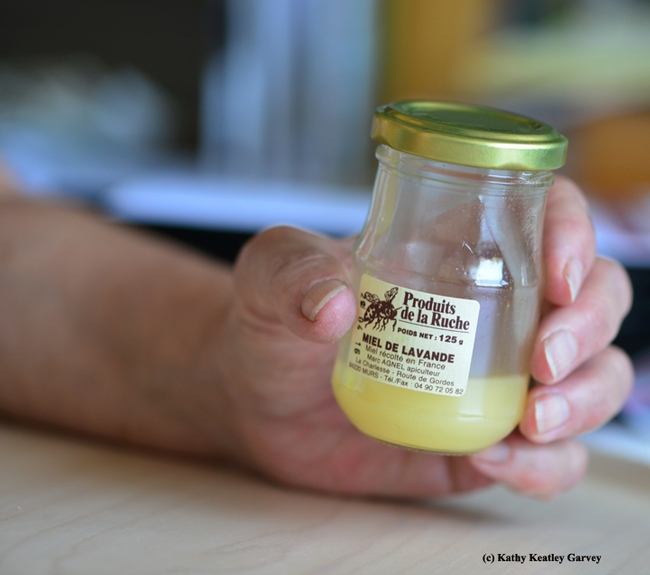
The "miel de lavande" produced by "apiculteur Marc Agnel" is creamed, as most lavender honeys are, she says. It arrived in San Francisco from France last week via my relatives (who love it).
"Honey from a specific plant doesn't always taste like the plant," Harris is saying, as she turns the wheel of the center's newly published Honey Flavor Wheel, a project benefitting bee health research at UC Davis. "Sometimes there is a bit of a surprise."
"Have the honey at room temperature, or slightly warmer, and covered," she advises. "This keeps all the volatiles inside the jar or cup."
Her observations about the honey and the procedure:
Aroma: The first scent is very floral with a touch of lilac. The next, overwhelming smell is fruit! Something very juicy.
Next: take a taste. Let the honey sit on your tongue and dissolve slowly. Try to assess all the flavors that might be occurring. floral – lilac; fruity – cherry
Primary taste: This honey is simply sweet.
Texture: This is a smooth and creamy honey. Quite unusual.
Finish: Notice how the taste lasts. This honey is delicate – that is, it has a very light and very distinct flavor. It has a short duration with a lasting aroma that is filled with a bit of cherry, lilac and the first taste of lavender!

“I have always been astonished by the range of flavors in honey. And its aromas, too. Developing the wheel has been an astonishing learning experience at all levels. I now truly pay attention as I taste many different kinds of foods. I notice flavors from beginning to end.
“I had one wonderful surprise during the tasting series," she recalled. "The sensory scientist we worked with, Sue Langstaff, had been to New Zealand and brought back several honeys. One was a wild flower called Viper's Bugloss. What an amazing aroma! Imagine sitting in a garden. The sun has just set. And the heady aromas of jasmine and orange blossom together crowd the air. This is the scent of Viper's Bugloss. An astonishing honey. Now I want more!”
The front of the colorful wheel lists the descriptors, including fruity, floral, herbaceous, woody, spicy, nutty, confectionary, caramel and earthy. No longer can you just say “sweet” when you taste honey or “sour, salty and bitter.” If it's fruity, can you determine if it's berry, citrus, dried fruit, tree fruit or tropical fruit? If it falls into the confectionary category, can you pinpoint marshmallow, vanilla, maple, butterscotch, toffee, molasses, cotton candy, crème brûlée, burnt sugar or brown sugar? There's even an “animal” category” where you may opine that your sample of honey reminds you of a barnyard.
The back of the Honey Flavor Wheel tells you how to taste honey and shares four honey profiles (Florida tupelo, California orange blossom, Northwest blackberry and Midwestern clover) “so the consumer can get an idea of how to use this innovative product,” Harris said.
(Check out the Sacramento Bee's YouTube video on Amina Harris's demonstration of the Honey Flavor Wheel.)
The Honey Flavor Wheel, measuring 8.25 inches, sells for $10 each, with all proceeds supporting bee health research at UC Davis. The product is available online and at several locations: the Honey and Pollination Center, located at the Robert Mondavi Institute for Wine and Food Science on Old Davis Road; at the UC Davis Campus Bookstore and at the downtown Davis Campus Bookstore; and online.
Attached Images:


